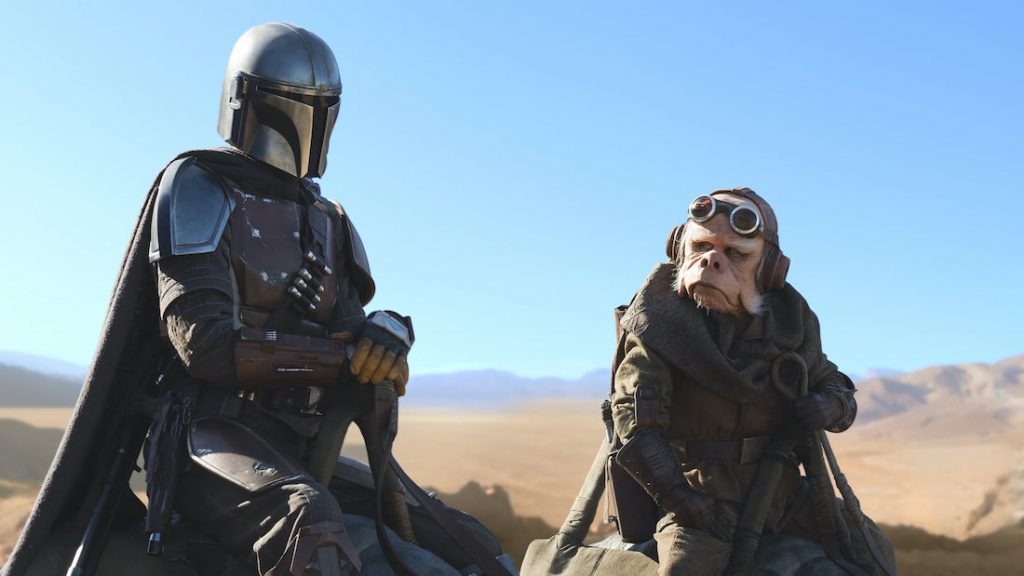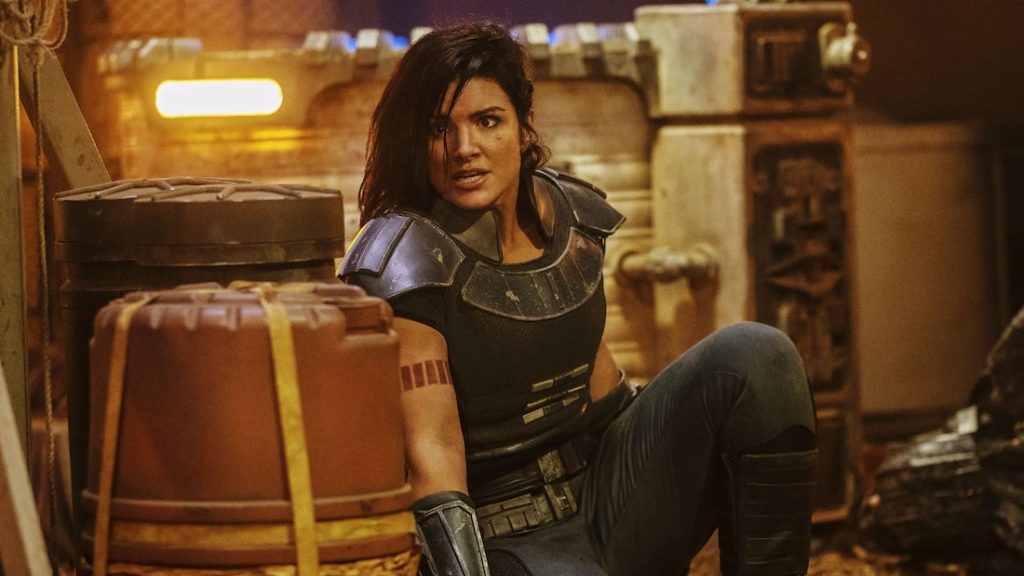THE MANDALORIAN – Season One
The travels of a lone bounty hunter in the outer reaches of the galaxy, far from the authority of the New Republic.

The travels of a lone bounty hunter in the outer reaches of the galaxy, far from the authority of the New Republic.


The Mandalorian is the most important Star Wars project of recent years, arguably since the Original Trilogy. Each episode follows ‘Mando’ (Pedro Pascal) to different parts of the galaxy in weekly stories held together by an overall arc. The show carving a new path is one of its greatest strengths; in fact, it’s at its worst whenever it leans too heavily on franchise familiarities and icons. Whether it be a dose of Star Wars fun and nostalgia or the action and drama of a one-man mission, this Disney+ series offers something for all ages.
The show lacks much of the Star Wars lore the ‘Skywalker Saga’ of nine movies are known for, like anything regarding the Jedi Order. The Mandalorian offers a more serious perspective, tackling the questionable morals of criminals and bounty hunters across the galaxy. No time is wasted on exposition, with The Mandalorian requiring a certain level of awareness for a universe that’s been part of pop culture for over 40 years.
The opening scene has Mando searching a barren tundra for alien bounty. It’s a day-in-the-life introduction, which sees him stir up a cantina before he finds who he’s after, takes him aboard his ship, then freezes him in carbonite. Liberties are being taken with Star Wars: The Empire Strikes Back‘s (1980) original intention behind carbonite, as that sequel made it clear this method of freezing is only done on gases, not solids or organics. But it’s certainly not the first time the franchise has rewritten its own history to aide future storylines.

Star Wars isn’t known for its quality scripts or purely character-driven stories. The Mandalorian’s script is harder to criticize than past entries, but still contains smart one-liners that define the series. “I gotta get one of those,” Mando says watching another Mandalorian fly past his ship wearing a jetpack. Elements of Han Solo’s impetuous attitude and Luke Skywalker’s benevolence are evident, and thankfully absent is any awkward carnal dialogue, such as Rey asking a topless Kylo Ren to put his shirt on.
Pedro Pascal’s Mando is always able to communicate without removing his helmet; something a Mandalorian is forbidden from doing in the presence of others. With just his body language and smooth voice, Pascal strikes an emotional chord, as his movements are so expressive and there’s never any doubt about what he’s feeling or thinking.
The cast of Disney’s sequel trilogy was more diverse than usual, and The Mandalorian likewise benefits from the talents of Giancarlo Esposito (Better Call Saul) and Carl Weathers (Predator) in big roles. The diversity merely accompanies the story rather than feeling like it has a point to prove. Instead of a princess, we now have a strong military woman called Cara Dune (Gina Carano) who’s introduced brawling with Mando and proving herself his equal.

‘The Child’ (a.k.a ‘Baby Yoda’) is introduced at the end of the pilot to serve as the mysterious ‘asset’ Mando must protect over the course of the season. The Mandalorian and The Child don’t represent the Dark and Light sides of the Force, as the show’s morals aren’t that clear-cut. Existing in a grey area, without having to always show its heroes in a positive light (or villains in a totally negative one), allows access to richer dynamics while still retaining everything that’s Star Wars. Mando himself is never supposed to be more than a middleman connecting clients with their bounty, no questions asked, but the series stems from his attachment and curiosity to one bounty in particular.
Season 1 has a revolving door of directors. This is a common practice for television, but the series undergoes some tonal shifts as a result. One story sees Mando helping a disgruntled gang on a prison break while another sees him mentoring a younger bounty hunter. The structure of the season has Mando jet off to different locations almost every week, encountering a different mix of people to help them complete a goal. While some may find this withholding of key plot points frustrating, I thought it worked as a fun way to arc the season. It reveals just enough to keep us invested while introducing a wide range of new characters to explore in the future. It also provides a great exposé of unexplored parts of this universe—barring one chapter entitled “The Gunslinger”, which exists solely to provide easter eggs to the franchise’s past.

The success of director Deborah Chow’s two entries cements her as an important part of the franchise. One of them sees Mando gathering his team, comprised of characters from past episodes, for a final showdown. However, my favourite episode is a self-contained story in the middle of the season called “Sanctuary” (although perhaps I’m just a sucker for director Bryce Dallas Howard’s homage to Jurassic Park‘s T-Rex), with Howard gives us a frightening and menacing, almost animalistic depiction of the AT-ST. The episode also has a spin on Seven Samurai (1954), whose director, Akira Kurosawa, served as great inspiration for George Lucas when he first created Star Wars. The most touching part of this chapter is an insight into the issues Mando faces, showing his longing to remove the helmet and settle down with someone, dare he entertain the thought long enough.
Taika Waititi (who also voices a droid) sits in the director’s seat for the finale, “Redemption”. The New Zealander’s latest movie, Jojo Rabbit (2019), earned an Academy Award nomination for ‘Best Picture, so I was as excited as I was disappointed by his instalment. For a show that had established itself as a slow-burn narrative, “Redemption” suffered from disjointed pacing which rushed the season’s ending. Mando’s long-awaited showdown against Mof Gideon (Esposito) was fantastic, but the story ends almost immediately after and characters just go their separate ways.

Jon Favreau is no stranger to cinematic universes after his influence on Marvel Studios after directing Iron Man (2008). He serves as creator, showrunner, and the lead writer on The Mandalorian, intending to explore a darker and grittier side of this movie matinee franchise. This is, however, still a Disney production. It fails to pack the hefty punch of dramas like Breaking Bad and Homeland, despite having down-to-earth storylines, higher stakes, and scarier villains than is typical for Star Wars. When Mando gets involved in a violent prison break, any loss of life is only implied off-camera, with creative camera angles and lighting. So while some aspects could shock a younger demographic, its softer touch may fail to grip adult fans after something grittier.
This series is unmissable for fans of science-fiction, whether they’re particularly excited by another Star Wars project or not. It avoids familiar territory and although there’s plenty of fan service, it wears its own armour with pride, reigniting what’s felt like an exhausted franchise. The Mandalorian‘s excellent first season is never short of action and treats the foundations on which it stands with respect while offering creative progression. Disney’s sequel trilogy left us riddled with anxiety over what Star Wars could possibly do next after divisive entries in Star Wars: The Last Jedi (2017) and Star Wars: The Rise of Skywalker (2019), but The Mandalorian has ironically delivered a new hope.


writers: Jon Favreau, Dave Filoni, Christopher Yost & Rick Famuyiwa.
directors: Jon Favreau, Rick Famuyiwa, Deborah Chow, Bryce Dallas Howard, Dave Filoni & Taika Waititi.
starring: Pedro Pascal, Carl Weathers, Werner Herzog, Nick Nolte (voice), Taika Waititi (voice), Gina Carano, Amy Sedaris, Jake Cannavale, Ming-Na Wen, Mark Boone Junior, Bill Burr, Natalia Tena, Clancy Brown, Richard Ayoade (voice), Ismael Cruz Córdova, Giancarlo Esposito & Emily Swallow.
